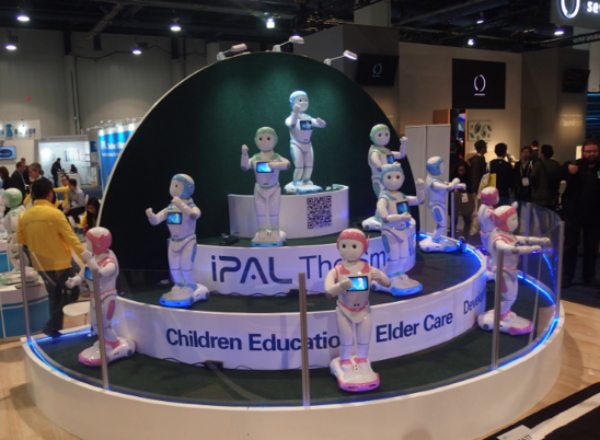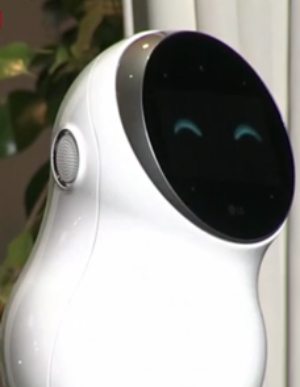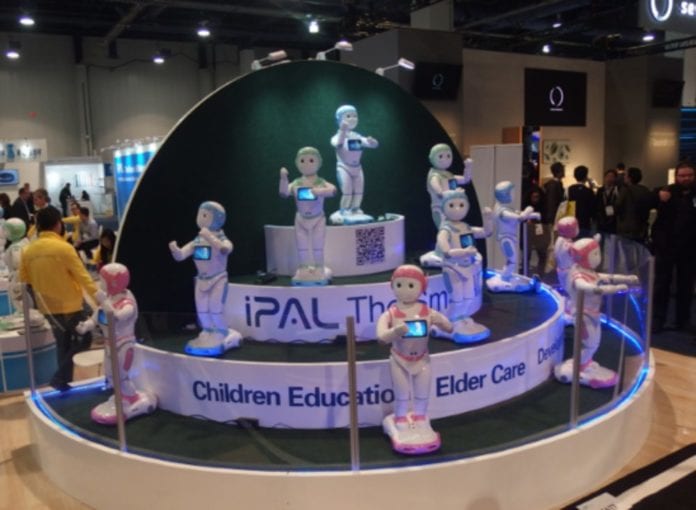The year kicked off, as usual, with the big CES show in Las Vegas. Some of the hot trends on display this year were AI, IoT, and Robotics. And while overall, the progress shown at CES is quite impressive, it seems like most of the robotics examples shown at CES were misuses of the promising field of robotics. Part of the cause is peoples’ endless need to anthropomorphize our creations.
 It is written that God created man in His image, but there is also a fairly strong case that it happened the other way around. Regardless of the direction, why is there such a strong, persistent desire to create replicates of ourselves, with heads, torso, arms, and legs — especially when that form appears to be irrelevant to performing the tasks of that given robot? Let’s contrast the Roomba, a well-known task-specific robot with iPal, a humanoid companion seen in this photo from CES.
It is written that God created man in His image, but there is also a fairly strong case that it happened the other way around. Regardless of the direction, why is there such a strong, persistent desire to create replicates of ourselves, with heads, torso, arms, and legs — especially when that form appears to be irrelevant to performing the tasks of that given robot? Let’s contrast the Roomba, a well-known task-specific robot with iPal, a humanoid companion seen in this photo from CES.
The iPal is positioned for children’s education or elder care. Worthy goals, but it’s unclear if the humanoid robots are capable of delivering on this promise. Displays of them dancing in unison (while playing the movie Frozen on their chest video screens) don’t make a very strong case. Khan Academy, starting with just a webcam, did more for education than any humanoid robot will this decade or the next. And there is no doubt AI, and personalized curricula will revolutionize, lower the cost, and improve education in the future…it’s just not obvious that we need C3PO to deliver the lessons.
LG had a CES keynote speech that leaned heavily on a cute little robot called CLio. But CLio failed embarrassingly on stage and didn’t respond to commands. Forgiving the curse of the demo gods, what was more important is the use cases being shown (or attempted) had little value-add, for example: “What’s on my agenda? Recipes, adjust the appliance setting.” These were things that are already easily achieved with a smartphone or a voice assistant. How is it better if the assistant is a humanoid device with childish voice, fake eyes, and rocking back and forth? Is the user experience more dependent on getting the command correctly executed, and having multiple compatible devices in the ecosystem…or how cute the “buddy” is?
 CES also had some mobile robots with integrated Amazon Alexa voice assistant, which would follow you around the house (but only on flat floors) and answer the same questions that a few $40 Echo Dots would answer without all the hassles. All had irritating “friendly” cartoonish voices, to appear endearing and cute. But what is truly lacking from this largest category of robots at CES is an actual valid use case, and certainly, one that would validate the increased costs over an Amazon Echo Dot or Google Home.
CES also had some mobile robots with integrated Amazon Alexa voice assistant, which would follow you around the house (but only on flat floors) and answer the same questions that a few $40 Echo Dots would answer without all the hassles. All had irritating “friendly” cartoonish voices, to appear endearing and cute. But what is truly lacking from this largest category of robots at CES is an actual valid use case, and certainly, one that would validate the increased costs over an Amazon Echo Dot or Google Home.
In Japan, companies make the case that the aging population will need additional caregivers and companionship and that robots may fill that need. While it is clear how a Roomba or an automatic dishwasher may help the elderly, it’s less clear how useful or healthy it is to substitute human contact with an AI. And even less whether a humanoid shape is necessary when so doing. A simpler product like Lenovo’s Smart Display could help homebound seniors have ease-of-use, companionship, but through contact with other real humans.
On the other hand, Sony may be on to something with its latest Aibo robotic dog companion. Even though dogs are very complicated animals, they are an order of magnitude less complex than humans, and thus a more worthy initial target for today’s AI-infused robots. Where it is nearly impossible (caveat: today) to replace human companionship with AI and a bot, it is a far simpler task to replicate a dog’s responses to specific conditions (see: Pavlov’s Dog).Tellingly, the Aibo had a very positive reception from the press at CES.
There is one compelling practical reason to design a robot as a humanoid, with similar mobility as us. That reason is that, for now, the world we have designed and built is designed for us. Handheld tools are made to fit our hands. Washing machines’ doors and buttons are placed for our easy access. We have built and placed things in our reach, and so for a single general-function robot that can vacuum our floor, open our doors, do our laundry, drive our car, clear snow with our shovel, it would have to be a humanoid shape. This plays well for the robots of science-fiction, like the Terminator, the movie AI, Asimov’s Foundation series…but we’re not there yet. For a while, robots are more limited and task-specific like the Roomba. Even Roomba has an entirely different model for mopping and yet another for vacuuming your pool.
And cost plays an important role in the limitations of humanoid robots. Most of the mobile humanoids at CES were, while human-shaped, much smaller. Materials cost money, as to actuators, motors, and batteries. So, these humanoid robots cannot do human-sized tasks, like cook on your range, or pull your vacuum from the closet and clean up a spill. For now, a better option is a battery-powered Amazon Echo in an old roller skate that you attach to your belt with a string.
That said, not all robots at CES were a technology looking for a market. CES also had task-specific, highly functional robots that have important use-cases and productive applications. Most notably, the army of robot cars that descended on the streets of Las Vegas for live demos. These showed how a narrowly-defined task could be met with high reliability from robotics. Also, a couple of oversized, automated drones that can transport humans inspired the crowd, with the Volocopter making an appearance in the keynote by Intel. Sure, these products have their hurdles to overcome, but they work today, and few people doubt the utility they could offer.
Even though the show floor at CES leaves the impression that robotics is a whimsical field with few practical uses, the truth is that Robotics is making a significant impact on our world. The best robotics solutions today are not in humanoid playthings, but instead found in industrial applications, manufacturing, agriculture, military, automotive, and other fields where the “robot” aspect may be hidden inside a familiar shape.

